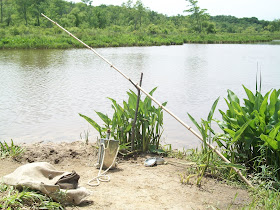 |
Washington would commit Greene's Division at Brunswick in June only after
clear intelligence from his partisan scouts that Howe moved to withdraw from New Jersey. |
The actions between the lines forced Howe to ship provisions from New York, but the daily skirmishing continued. Von Ewald raided to the north across Bound Brook on April 4th and returned with fifteen head of cattle. [1] On the 14th his jaegers formed the advanced guard for General Grant's forces in an attack while light infantry was to march to Quibbletown to cut off the colonial forces escape. Evald ran into piquets just before dawn south of the bridges. As the sun rose, the American piquets pinned down the jaegers with musket and rifle fire until Von Donop's Hessians deployed from column ten minutes later. Then light infantry was late, according to Ewald, and only three hundred colonials were captured once the militia outposts were over run, suggesting a much larger force was opposing the Hessian raid at Bound Brook.[2] American reports confirm Ewald's assertion that General Lincoln may have retreated without his breeches or at least that he surrendered possession of the town, not to mention two artillery pieces, two subalterns and twenty men from Proctor's Regiment also among the lost. To their credit, Lincoln's troops retook the fords ninety minutes later.
[3]
 |
| Skirmish at Bound Brook, by Von Ewald [4] |
The weeks that followed were constant skirmishing across the Raritan River and in the area South-East of the Continental encampment at Morristown and took their toll on both Washington and Howe's forces. Howe attempted to lure Washington out of the mountains by landing the 17th Light Dragoons, Heavy Artillery, and pontoons at New Brunswick on June 12th, with fighting instensifying from the 13th to the 19th. [5] Wrote one Virginia officer in a letter of the 13th,
"
We have been encamped on this ground about 20 days, had just got all our old warriors drwan together, and began to live together in a most social manner. Sir William [Howe]
, that disturber of man's peace, could not endure to hear of our happiness, he is likely to give us some trouble in a day or two, indeed I look for it every moment. Our intelligence says their wagons is loaded...from every circumstance Philadelphia is their object. We are watching them every moment...our game will be to act upon their flanks and rear...Howe has come over himself...if we can give him a rap over his fingers it settles the campaign." [6]
Washington was further informed that Howe was moving to embark the army (on the 19th) and was convinced of it by the 20th,
"I am now to aquaint you, that after encamping between these two posts, and beginning a line of redoubts, they changed their ground...and returned to Brunswick again, burning several valuable dwelling-houses...on first notice of the enemy's movements, the militia assembled in the most spirited manner, firmly determined to give them every annoyance in their power, and afford us every possible aid."[7]
Washington immediately followed by sending a reconnaissance in force towards Bound Brook, Samptown, and Quibbletown on the 21st resulting in heavy fighting at those outposts.[8] On the 22nd, Washington committed Greene's Division, Wayne's Pennsylvanians and Morgan's Riflemen against Howe's rear guard at Brunswick.
[9] The British and Hessians surrendered the redoubts and retreated towards Amboy, dogged by the American riflemen, among whom were men detached from the First Virginia Regiment. By the 24th it was clear even to the soldiers that Howe was pulling the army out of Amboy and embarking them for Staten Island.
[10] Stirling's Division fought a rear guard action againt Cornwallis at Short Hills on the 26th, allowing the main body of the Continental Army to retrograde to Morristown, effectively ending Howe's window of opportunity to crush the rebel army.
Washington's partisan war had achieved the desired results, but only for the moment. By the end of the year, Philadelphia would be in British hands with the Continentals watching from the hills of Valley Forge.
[1] Von Ewald,
Diary...(55).
[2] Von Ewald,
Diary...(56-57).
[3] Dixon and Hunter, Virginia Gazette, No. 1342, 2 May 1777, (3). Colonial Williamsburg's Rockefeller Library Collection.
[4] Von Ewald,
Diary...(59).
Bloomburg Univ. of PA Archives., accessed 1 May 12.
[5] Von Ewald,
Diary...(65)
[6] Dixon and Hunter, Virginia Gazette, No. 1350, 27 Jun 1777, (2).
[7] Dixon and Hunter, Virginia Gazette, No, 1351, 4 Jul 1777, (7).
[8] Von Ewald, Diary...(65).
[9] Dixon and Hunter, Virginia Gazette, No. 1352, 11 Jul 1777, (1)
[10] Dixon and Hunter, Virginia Gazette, No. 1351, 4 Jul 1777, (3).












.JPG)











